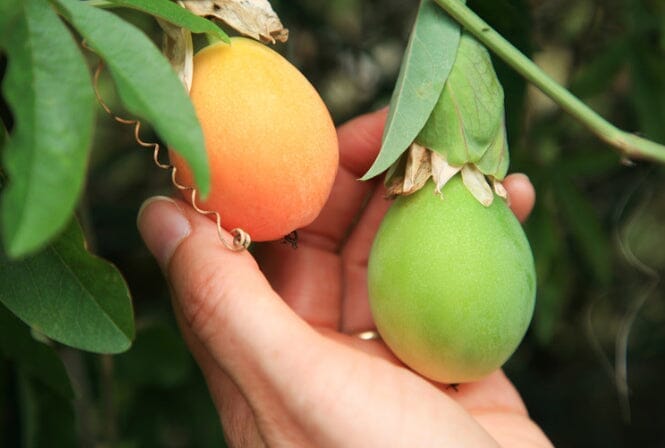
How to Grow Passion Fruit Vine: Best Tips for Thriving Plants
Share
If you want to know how to grow passion fruit vine, you’re in the right place. From choosing the best variety to planting and caring for your vine, this guide covers everything you need to ensure a successful and fruitful growth.
Key Takeaways
- Choose the right passion fruit variety based on your climate to ensure optimal growth!
- Prepare your planting area with well-drained soil and a sturdy trellis for thriving vines!
- Proper care, including consistent watering and pruning, is essential for a bountiful passion fruit harvest!
Choosing the Right Passion Fruit Variety

Choosing the right passion fruit variety is essential for a successful gardening experience. Each type thrives in specific temperate climates, and knowing which one fits your local conditions can greatly impact your garden’s success.
From the cool-loving Purple Passion Fruit Vine to the tropical Yellow and Red varieties, each has unique characteristics and flavor profiles. Exploring these varieties will help you make an informed decision.
Purple Passion Fruit Vine
The Purple Passion Fruit Vine, native to southern Brazil, Paraguay, and northern Argentina in South America, is popular in subtropical and tropical climates. Its sweet and tangy flavor thrives in full sun, with protection from strong winds.
The ‘Possum Purple’ variety is self-fertile, providing a good yield from a single vine. Minimal pruning and growth up to 2-3 feet in height make the Purple Passion Fruit Vine a fantastic garden addition.
Yellow Passion Fruit Vine
The Yellow Passion Fruit Vine is versatile and vigorous, suitable for all gardening levels. Known for its sweet, tangy fruits with tropical flavor and floral notes, it can reach 2-3 feet in height and thrives robustly.
This variety is perfect for adding a tropical plant touch to any garden.
Red Passion Fruit Vine
The Red Passion Fruit Vine, known as Maracuya, offers an aromatic and intensely sweet flavor. Its unique balance of sweetness and tartness makes it a delightful garden addition.
With its vibrant fruits, the Red Passion Fruit Plant Vine adds aesthetic appeal and a burst of flavor to your fruit plant garden.
Read: 8 Essential Fruit Plants for Your Backyard Garden
Preparing Your Planting Area
The right planting area is crucial for the health and productivity of your passion fruit vines. These tropical plants thrive in well-drained, fertile soil that retains moisture and needs regular watering, especially in the growing season.
A sturdy support structure is necessary, as passionfruit vines can become quite heavy. Understanding soil, sunlight, and trellis setup requirements will ensure your vines flourish.
Soil Requirements
Passionfruit vines require well-draining soil to prevent root rot and ensure healthy growth. Amending the soil with organic materials like compost can enhance fertility and improve drainage. The ideal soil pH level for passionfruit vines is between 5.5 to 6.5, creating an optimal environment for nutrient absorption.
Meeting these soil criteria sets your vines up for success.
Sunlight and Placement
Passion fruit vines thrive in full sun to partial shade. Positioning them in a warm, sunny spot ensures they receive direct sunlight and the energy needed for vigorous growth and fruit production.
Trellises or fences offer the support needed for the vines to climb, promoting strong and healthy growth.
Spacing and Trellis Setup
Adequate spacing and a strong trellis setup are vital for supporting passionfruit vines. These plants need plenty of space, free from weeds and competing plants, to grow and spread their roots.
Wooden or wire trellises, fences, or arbours are suitable support structures, helping vines climb and bear fruit weight. Using concrete-reinforced mesh (reo) is also recommended for added support.
Planting Passion Fruit Vines

Planting passion fruit vines at the right time with proper techniques ensures successful establishment. Incorporate compost and chicken manure into the soil to enhance fertility and provide essential nutrients. Pre-moisten the seed starting mix and ensure pots have a strong support structure.
Understanding the optimal timing and detailed planting steps will help your vines thrive when they are properly planted.
When to Plant
Plant passionfruit vines in early spring after the last frost. This timing gives the vines the entire growing season to establish and grow vigorously. Frost can damage young plants and hinder their growth.
Planting Steps
Enrich the soil with compost and mulch to promote healthy growth. Dig wide holes that allow the roots to spread comfortably and set the vines a few feet apart for adequate space.
This spacing ensures the vines have enough room to grow without competing for nutrients and sunlight.
Caring for Passion Fruit Vines

Proper care is essential for the health and productivity of passion fruit vines, including consistent watering, appropriate fertilizing, and regular pruning to grow passion fruit and maintain shape and health.
Passion fruit vines are susceptible to environmental factors like frost and drought, so managing these conditions is crucial. Understanding specific care requirements will ensure your vines thrive.
Watering
Consistent moisture is key for healthy growth and fruit production. Deep watering helps establish roots and prevents drought stress, especially during flowering and fruiting periods. It is important to water deeply to ensure optimal moist levels.
Irregular watering can lead to root rot and other issues.
Fertilizing
Fertilizer with the right nutrients is crucial for healthy fruit production. Citrus food, chicken manure, and potassium-rich fertilizers are ideal choices that have been produced for optimal results.
Start by listing some forbidden forms of the keyword “summer” according to the rule 5. Then, find out if there’s a chance to incorporate the keyword without making any extra assumptions, according to the rule 2. Keep it short.
Apply these fertilizers twice a year, at the start of the growing season in spring and once more during the summer season, to promote vigorous growth and fruit production.
Pruning
Pruning helps maintain shape, improve air circulation, and remove diseased or dead branches. Selective pruning encourages new growth and keeps the vines healthy and productive.
Regular pruning ensures the entire root system supports a manageable amount of foliage and fruit, while also promoting extensive root systems on the ground. Additionally, to maintain health, it is essential to prune.
Managing Common Issues
Even with the best care, passionfruit vines can face issues like pests, diseases, poor pollination, and environmental stress. Managing these problems will help maintain the health and productivity of your vines.
Let’s explore the common issues in passion fruit vines and effective solutions.
Pests and Diseases
Pests like aphids can transmit the woodiness virus, causing distorted leaves and thick rinds on fruits. Fungal infections such as brown spot and fusarium wilt can also affect the vines.
Ensure good airflow around the plants, practice crop rotation, and apply appropriate fungicides or insecticides as needed to manage these issues.
Poor Pollination
Poor pollination can lead to a lack of fruit. Over-fertilization can cause excessive leaf growth without flowers and fruit.
While a single tree can self-pollinate, having multiple trees increases the chances of successful pollination and overall fruit yields.
Environmental Stress
Frost, wind, and drought can significantly impact the health of passionfruit vines. Frost can damage young vines, while strong winds can break branches.
Drought conditions can also affect fruit yield and overall plant health.
Harvesting and Enjoying Your Passion Fruit

Harvesting at the right time ensures optimal flavor and quality. Passion fruits are fully ripe when they drop from the vine or when their color is fully developed.
Understanding the signs of ripeness, proper harvesting techniques, and ways to enjoy this delicious fruit will maximize your passion fruit experience.
Also check our blog How to harvest passion fruit vine
Signs of Ripeness
Ripe passion fruits have a dark purple or yellow-orange color, depending on the variety. They feel heavy, full of juice, and often have a fragrant, sweet smell.
Slightly wrinkled passion fruits are overripe and have a sweeter flavor.
Harvesting Technique
Use pruning shears to cut the stem of the fruit to avoid damaging the vine.
Freeze the pulp if you harvest more passion fruits than you can consume.
Using Passion Fruit
Enjoy passion fruit fresh, directly from the skin, or in desserts like tarts and mousse. It also adds a flavorful tropical twist to drinks such as juices, cocktails, smoothies, and a passion fruit recipe.
Consuming passion fruit provides health benefits, including boosting the immune system and promoting digestive health, so it is beneficial to eat passion fruit.
Summary
Growing passion fruit vines is a rewarding endeavor that brings the tropical taste of paradise right into your backyard. By choosing the right variety based on your climate and preferences, preparing the planting area with care, and providing proper care through watering, fertilizing, and pruning, you can ensure your passion fruit plants thrive. Managing common issues like pests, diseases, and environmental stress will keep your vines healthy and productive. Finally, knowing when and how to harvest your passion fruits allows you to enjoy their delicious flavor at its peak. So, fellow gardeners, take these tips and start your journey to grow passionfruit vines, reaping the rewards of your efforts with every juicy bite!
➡️ Passion Fruit Yellow vs Purple: Taste, Nutrition, and Growth
Frequently Asked Questions
What is the best time to plant passionfruit vines?
The best time to plant passionfruit vines is in early spring, right after the last frost! Get ready to enjoy those delicious fruits!
How do I know when my passion fruits are ripe?
You’ll know your passion fruits are ripe when they’re a deep purple or yellow-orange, feel heavy in your hand, and release a sweet, fragrant aroma! Get ready to enjoy that delicious flavor!
What type of soil is ideal for planting passionfruit vines?
For thriving passionfruit vines, go for well-draining soil enriched with organic compost, ideally with a pH between 5.5 to 6.5. Your vines will thank you for it!
How often should I fertilize my passionfruit vines?
You should fertilize your passionfruit vines twice a year—once in spring at the start of the growing season and again during the season. This will help them thrive and produce delicious fruit!
What should I do if my passionfruit vines are not producing fruit?
If your passionfruit vines aren’t producing, it’s time to check their pollination! Make sure you have multiple plants for better fertilization and don’t over-fertilize—your vines will be thriving with a little attention!

